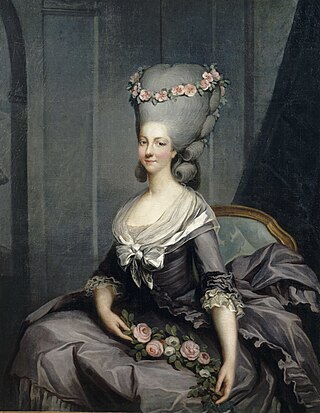
A lady-in-waiting or court lady is a female personal assistant at a court, attending on a royal woman or a high-ranking noblewoman. Historically, in Europe, a lady-in-waiting was often a noblewoman but of lower rank than the woman to whom she attended. Although she may either have received a retainer or may not have received compensation for the service she rendered, a lady-in-waiting was considered more of a secretary, courtier, or companion to her mistress than a servant.

Marie Aimée de Rohan was a French courtier and political activist, famed for being the center of many of the intrigues of the first half of the 17th century in France. In various sources, she is often known simply as Madame de Chevreuse.

Anne d'Arpajon, comtesse de Noailles was a French noblewoman and court official. She served as the dame d'honneur of two Queens of France, Marie Leszczyńska and Marie Antoinette. She was called "Madame Etiquette" by Marie Antoinette for her insistence that the minutiae of court etiquette could never be altered or disregarded.

A prince du sang is a person legitimately descended in male line from a sovereign. The female equivalent is princess of the blood, being applied to the daughter of a prince of the blood. The most prominent examples include members of the French royal line, but the term prince of the blood has been used in other families more generally, for example among the British royal family and when referring to the Shinnōke in Japan.

Marie Thérèse Louise of Savoy, Princesse de Lamballe was a member of the Savoy-Carignano cadet branch of the House of Savoy. She was married at the age of 17 to Louis Alexandre de Bourbon-Penthièvre, Prince de Lamballe, the heir to the greatest fortune in France. After her marriage, which lasted a year, she went to the French royal court and became the confidante of Queen Marie Antoinette. She was killed in the massacres of September 1792 during the French Revolution.

The Camarera mayor de Palacio was the Official of the Royal Household and Heritage of the Crown of Spain, who was in charge of the person and the rooms of the Queen of Spain.

Pauline Marie Ghislaine de Bassano, née van der Linden d'Hooghvorst, was a French courtier. She served as dame d'honneur to Empress Eugénie de Montijo in 1853–1867.

Marie-Anne Walewska, Duchess Colonna-Walewski,, was a French courtier and royal mistress. She served as Première dame d'honneur to Empress Eugénie de Montijo in 1868–1870, and was the last to perform this function in France. She is also known for her relationship to Emperor Napoleon III of France in 1857–1861.

Anne Debelle, Princesse d'Essling, was a French courtier. She served as Grand-Maitresse to Empress Eugénie de Montijo in 1853–1870.
Court Mistress or Chief Court Mistress is or was the title of the senior lady-in-waiting in the courts of Austria, Denmark, Norway, the Netherlands, Sweden, Imperial Russia, and the German princely and royal courts.

Première dame d'honneur, or simply dame d'honneur, was an office at the royal court of France. It existed in nearly all French courts from the 16th-century onward. Though the tasks of the post shifted, the dame d'honneur was normally the first or second rank of all ladies-in-waiting. The dame d'honneur was selected from the members of the highest French nobility.

Dame d'atour was an office at the royal court of France. It existed in nearly all French courts from the 16th-century onward. The dame d'honneur was selected from the members of the highest French nobility. They were ranked between the Première dame d'honneur and the Dame du Palais.

Première femme de Chambre was an office at the royal court of France.

Laure Auguste de Fitz-James, Princesse de Chimey was a French courtier. She served as lady-in-waiting to Queen Marie Antoinette from 1770 to 1791.

Louise Emmanuelle de Châtillon, known as Princesse de Tarente (1763-1814) was a French noble, memoirist and court official. She served as lady-in-waiting to queen Marie Antoinette of France from 1782 to 1792. Her memoirs about her life during the French Revolution has been published.

The Dame du Palais, originally only Dame, was a historical office in the Royal Court of France. It was a title of a lady-in-waiting holding the official position of personal attendant on a female member of the French Royal Family. The position was traditionally held by a female member of a noble family. They were ranked between the dame d'atours and the Fille d'honneur. They had previously been styled 'Dames'.
Adélaïde Diane Mancini called, Mancinette, was a French court official. She served as the dame d'atour to queen Marie Antoinette from 1771 to 1775. She is known to have curbed the expenses of the queen's wardrobe during her time in office and created order in the queen's economy, which was however ruined by her successor.

Anne Mortier de Trévise, marquise de Latour-Maubourg (1829-1900), was a French courtier. She served as lady-in-waiting to the empress of France, Eugénie de Montijo.

Louise Poitelon du Tarde, vicomtesse de Lezay-Marnésia (1826–1891), was a French courtier. She served as lady-in-waiting to the empress of France, Eugénie de Montijo.

Nathalie de Ségur, baronne de Malaret was a French courtier. She served as lady-in-waiting to the empress of France, Eugénie de Montijo.



















